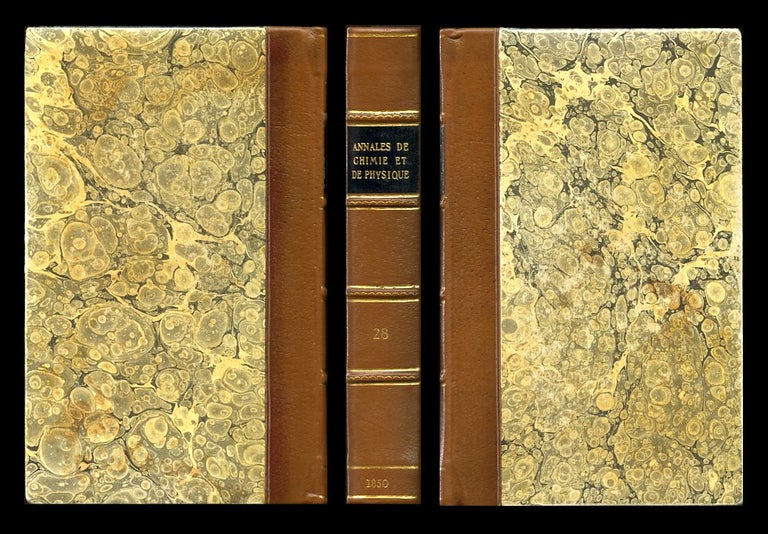Recherches sur la Polarisation de la Chaleur (pp. 252-255, Provostaye) WITH Mémoire sur la conductibilité superficielle des corps cristallisées pour l’électicité de tension (pp. 257-278, Sénarmont) and Note sur un Nouveau Polariscope (pp. 279-292, Sénaramont) in Annales de Chimie et de Physique, Vol. 28, 1850
Paris: Victor Masson, 1850. 1st Edition. FIRST EDITION OF PROVOSTAYE & DESAINS PHOTOMETRIC EXPERIMENT & FORMULA FOR CALCULATING THE AMOUNT OF LIGHT TRANSMITTED THROUGH (OR REFLECTED FROM) A PILE OF PLATES. In optics, a set of flat transparent plates mounted at some angle to incident light functions as a simple polarization device. To date, most references that contain an expression for the degree of polarization of a pile of plates utilize the formula of Provostaye and Desains presented in this paper.
The formula presented by French thermo-chemists Frédéric Hervé de La Provostaye and Paul Desains assumes an “infinite series of multiple reflections between all surfaces, i.e., multiple reflections within and between plates” (Bennett, Polarisation, 5.16). Provostaye and Desains “found the degree of polarization P of the transmitted rays related to the intensities of the reflected and refracted rays and can be calculated by a formula with refractive index n of the slabs staked m times” (Polarization of Light, About Physics Portal). Their formula utilized the total transmission of the p-polarized component as well as the partial reflection of the s-polarized light.
ALSO INCLUDED ARE FIRST EDITIONS OF TWO PAPERS BY SÉNARMONT: (1) “Mémoire sur la conductibilité superficielle des corps cristallisées pour l’électicité de tension” [On the superficial conductibility of crystallized bodies for electricity of tension], pp. 257-278. In this paper, Henri Hureau de Sénarmont established the directional dependence of surface conductivity in crystals. “He discovered this dependence by wrapping a crystal in tinfoil (which had been grounded) and by placing a metal point on the crystal surface at a point where a circular piece of the tinfoil had been cut out; the point was then connected to the positive conductor of an electrostatic machine, and the whole apparatus was placed under the glass bell of an air pump. At reduced pressure he was able to observe, in the dark, circular or elliptical figures of light, depending on the nature of the crystal” (DSB). His research “showed that different phenomena are subject to the symmetry of the crystal form” (Katzir, Piezoelectricity, 84).
(2) “Note sur un Nouveau Polariscope” [On a new polariscope], pp. 279-282, Sénarmont describes a plate composed of four quartz prisms with its upper and lower faces normal to the optic axis. His invention “affords a very accurate means of determining the position of the plane of polarization of any source of light which is partially or wholly polarized” (Preston, The Theory of Light, 476). A Sénarmont polariscope suitable for optical maser work has even been constructed.
ALSO INCLUDED are papers by Matteucci, Biot, Becquerel, and Pasteur. Item #833
CONDITION & DETAILS: Paris: Victor Masson. (8.25 x 5.5 inches; 206 x 138mm). Bears one small number stamp on the rear of the title page and small stamp on the half title. [2], 504, [2]. 5 fold-out plates. Handsomely rebound in half-calf over marbled paper boards, gently scuffed at the edges for an ‘aged’ effect by the conservator; 4 gilt-ruled and tooled bands at the spine; gilt-lettered black morocco spine label. Tight and very solid. Occasional light toning within; largely very clean inside and out. Near fine condition.
Price: $150.00

